 |
The Saint of the Day
St. Gush ad Azad, June 12
Prof. Plinio Corrêa de Oliveira
Biographical selection:
The Catholic Religion was preached with success in Persia by St. Matthew and St. Bartholomew, and the Christians in this country had a deep faith. In the fourth century, Emperor Shapur II (310-381) began a fierce persecution against those who would not worship the sun. There were countless Catholic martyrs who perished because they refused to accept the Persian religion.
Worship of Mitra (the sun god) was an ancient practice of the Persians. From their pre-history to Cyrus, the first Persian King of Kings, the Persians always adored the sun. Therefore, they wanted to make Catholics adore the sun as well.
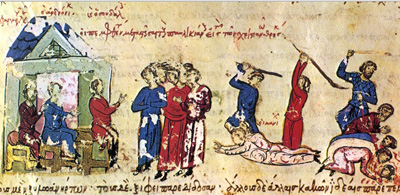
Sources record that 1,150 martyrs
perished under King Shapur II |
For this reason, in the year 344 the Emperor ordered Simeon, Bishop of Susa, to be imprisoned. Bishop Simeon had been a friend of Gush ad Azad, an eunuch of the palace who was a counselor of the Emperor and famed throughout the empire. He had become a Catholic but, fearing persecution, had abjured his Faith.
As he was led off to the prison, Bishop Simeon passed by the eunuch, who greeted him. But the holy Bishop turned away and diverted his gaze from the apostate with an indignant horror. That silent disapproval profoundly touched Gush ad Azad, who wept bitterly for several days, crying to himself, “Woe to me, when I stand before my God, from whom I am cut off! For if my friend Simeon has turned his back on me, what will be the response of God, whom I betrayed?”
Consumed by these thoughts, the eunuch exchanged his fine attire for coarse mourning garb, causing great surprise among all at the court. The Emperor Shapur soon called his counselor to his presence to ask what had happened for him to cast such dreary presages over the empire.
The eunuch answered: “I am dressed in mourning garb because of my twofold perfidy: against my God and against you. Against my God, because I abjured the faith to which I had sworn; I preferred your favors to the truth. Against you, because since I was obliged to adore the sun, I did it with hypocrisy; my heart internally protested my action.”
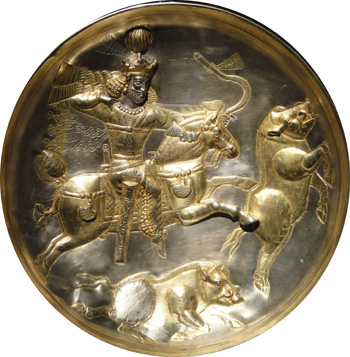
The longest reigning monarch of the Sassanid dynasty,
King Shapur II ruled from 309 to 379 |
Threatened by Shapur II, Gush ad Azad remained unyielding in his position and was condemned to death. Before the execution, however, he asked a last favor from the Emperor. He said to him:
“You have always praised me for the zeal and dedication with which I have served you and your father. Now, I asked you this mercy: that a herald should announce to the people that Gush ad Azad was put to death not because he betrayed the secrets of the Emperor or was involved in some conspiracy, but rather because he is Catholic and refused to deny his God.
“My apostasy was known by the entire city, and my weakness may have affected many persons. If they hear now about the penalty without knowing the cause, my death will not serve as an example for the faithful. To the contrary, if they know of my repentance and that I die for Christ, I will fortify their spirits; their souls will become firmer and their ardor re-inflamed. The voice of the herald will be like a war trumpet that gives the athletes of justice the signal for combat and warns them to prepare their weapons.”
So it was done. St. Gush ad Azad was killed on Maundy Thursday in the year 344.
Comments of Prof. Plinio:
This is a very beautiful report. You know about the custom adopted in many countries of Antiquity of mutilating some boys so that they would lose their virile potency. These eunuchs were then charged with watching over the harems where the wives of the kings stayed, without rousing concerns in the monarchs.
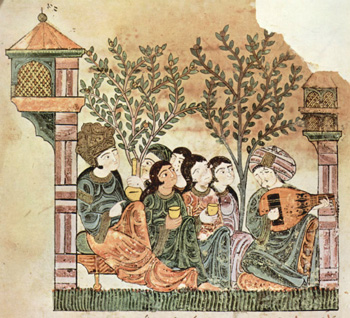
An Arab harem |
This fact alone reveals the fragility of those old institutions, which some historians try to present as being very strong. Instead, they were monarchies established exclusively on fear and coercion. The wife of a king could only be safe in the presence of a mutilated man. Should she be served by normal men, despite the power of the king, he could be betrayed by her and one of his men. You understand what kind of atmosphere this creates for a civilization and the grim repercussions it has over all of the social, political and economic institutions.
On the other hand, when we study the Middle Ages, we see that the bond that properly united and coordinated the elements of a medieval institution was the bond of fidelity. Such fidelity made it a point of honor for both the superior and the inferior to carry out their reciprocal duties without injuring or infringing on the rights of the other; the shame for one who violated this trust was great, greater for the one who breached the trust than for the one who was betrayed.
And while it was an infamous act for a wife to cheat on her husband, it was considered even more infamous for a man to deceive his lord by stealing his wife. You see how much more elevated Catholic Civilization was than the turbid villainy of the Ancient World.
It so happened that those mutilated men often came into contact with the kings because of their familiarity with the palace. Since these men usually did not take part in the orgies and disorders of the common men at court, they used to read and study much more and thus to become much more learned than the others. The consequence was that very often they ascended to higher posts of State: they would become counselors, tutors, generals etc of emperors, kings or governors, many of them attaining a high profile in the country.
This was the case of Gush ad Azad, who became an eminent personage of one of the greatest empires of Antiquity, which was the Persian Empire. He became Catholic in the wake of the apostolate of St. Bartholomew in Persia and began to practice the religion. But then Emperor Shapur promulgated a decree condemning all Catholics to death. Moved by fear he disavowed the faith. The holy Bishop Simeon passed by him; the eunuch greeted him but the Bishop averted his gaze from the apostate and continued on his path to martyrdom. That action shook Gush ad Azad and led to his conversion.
You see how different the paths of grace are. Our Lord passed by St. Peter and gazed at St. Peter with goodness. He converted St. Peter forever. One might say that that Bishop should have imitated Our Lord and gazed at the apostate Gush ad Azad with goodness. But the Holy Spirit suggests different actions for the different paths He uses to lead souls.
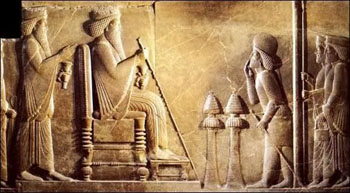
The repentant apostate is brought before the King, |
In this case, what happened was that the Bishop was filled with horror and indignantly diverted his gaze from the apostate. Instead of revolting, the apostate was touched by grace. Then, as we saw, he made this reasoning: “For if Simeon has turned his back on me, what will be the response of God, whom I betrayed?” And he decided to change his life.
We see the varying paths of God, how differently He inspires the apostolate of each one. To some He gives a contagious love, which through its sweetness leads to union with Him; to others He gives a sacred and sublime ire, which purifies like fire and directs the souls that are the object of that ire toward Him.
Here you have a beautiful conversion, a profound conversion like that of St. Peter, although by means of a different path. Like St. Peter, Gush ad Azad wept bitterly for his sin; like St. Peter, he walked toward martyrdom, although by a different way.
How did he walk? The scene reflects the theatricality of the Orient, that beautiful and picturesque theatricality, which I like very much. According to Western patterns, he should have written a letter asking for a last favor. Or he should have left a letter in his house and fled. In the Ancient World it was relatively easy to disappear since the police system had a less efficient means of information and action and a rebel could quietly escape and lead a somewhat easy life.
Thus, ad Azad could have entered a hermitage in some desert place or left Persia with enough riches and jewels to permit a tranquil life in another country where the Catholic Religion was already established. But, no, he resolved to face martyrdom.
Instead of writing a letter, he felt in his oriental soul the need to express with symbols what he would say with words. So this powerful man appeared in the palace dressed in mourning garb – I am not aware of what color the Persians of that time used to express their mourning: Was it purple? Was it black? I do not know. But it was certainly something dramatic, worn to produce a theatrical effect, which in this case it did. The persons who crossed paths with him were all surprised: “Why is the great Gush ad Azad, one of the highest dignitaries of the Empire, wearing mourning garb?”
Theater is not always hypocritical; many times it is a beautiful and splendid manifestation of the truth.

Ruins of a Persian palace |
So, you can imagine ad Azad, walking through the rooms of the palace with a grief-stricken face, his eyes filled with sorrow and sadness, with the slaves bowing as he passed. But he was not looking at anything or anyone; before him he only saw the sublimity of the ire of that Bishop who averted his gaze from him as he was led away to death. He finally arrived at the hall of the throne, where the Emperor had called him.
Certainly the Emperor did not greet him with our low-level Western “Hello! What’s up?”, but rather in a solemn voice: “So, why are you casting such presages of sorrow over my empire?” These are beautiful words to come from the heights of a throne in a magnificent room with slaves waving flabella; a room from which one could see a patio with sculptures in the shape of winged bulls and lions.
Then, before the gathered nobles and slaves, the dialogue unfolded. Gush ad Azad, said: “I sinned before God and before you…”
The Emperor condemned him to death, and he accepted the sentence with all serenity, with a full dignity. The Emperor was trembling with hatred, but Gush ad Azad did not tremble before the Emperor; he only trembled before the sublime intransigence of the man who had repudiated him.
He asked his last favor. He did not ask for his life. He asked that the heralds be allowed to go throughout the city of Susa, capital of the Empire, to proclaim that he had died because he was Catholic.
The Emperor accepted and ad Azad walked away to his death. Soon after, the heralds were in the streets proclaiming: “Gush ad Azad, the powerful minister, has died. This strong column of the Empire was cut down because he persevered in the Catholic Faith and did not accept the cult of the sun that we practice.”
We can surmise the great enthusiasm this news raised among the Catholics dispersed in the mob, who met later in the evening to comment about the new triumph of the grace of Our Lord. This example prepared them for fidelity and martyrdom. It
was a great enthusiasm because grace had raised up an invincible hero even from one made of the weak clay of the apostates.
How can we apply this to our lives?
You see that in the saddest situations, in those where human weakness appears more plainly, there is always a remedy. There is always the help of grace once we ask for it. Certainly Our Lady prayed for this man. He needed that prayer because he had fallen into a complete apostasy, because he had so many bonds to the world – he enjoyed many advantages in the co-direction of one of the greatest empires on earth. He was very far from Our Lady, but he was converted by her prayer.
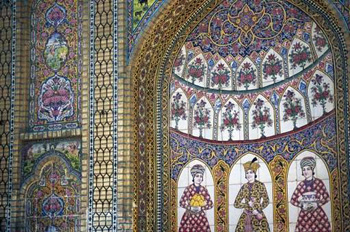
Persian mosaics that reflect the Oriental spirit |
His encounter with Bishop Simeon was obviously prepared by Divine Providence so that he might receive that averted gaze. The Bishop's reaction was inspired by grace. Then, that response was enough to regenerate a man who had abused so many graces. Suddenly that miserable apostate was transformed into a Saint of the Catholic Church, whose name we speak with respect.
We should have an unbreakable confidence in the mercy of Our Lady, in the omnipotence of her requests before God. We must always, always maintain the confidence that we – as well as the souls of those who disappoint, sadden and frustrate us – can ascend again to God and offer him the good fragrance of a perfect worship. Thus we should walk toward the future with joy, calm and confidence.
Let us direct to Our Lady a supplication that is part of the Anima Christi, which is Ne permitas me separare a te – Do not permit me to separate myself from you.
This is our conclusion: Our Lady did not permit this martyr to be separated from her. He went so far as to apostatize, but at a certain moment she called him back, and today Gush ad Azad shines in Heaven among the Saints.
Let us ask him to pray for us so that when we shall arrive in Heaven we may join him in his unity with Our Lady in the splendor of his glory, and that we may – with him – love Our Lady and Our Lord for all eternity.


  |
|
Prof. Plinio Corrêa de Oliveira | |
The Saint of the Day features highlights from the lives of saints based on comments made by the late Prof. Plinio Corrêa de Oliveira. Following the example of St. John Bosco who used to make similar talks for the boys of his College, each evening it was Prof. Plinio’s custom to make a short commentary on the lives of the next day’s saint in a meeting for youth in order to encourage them in the practice of virtue and love for the Catholic Church. TIA thought that its readers could profit from these valuable commentaries.
The texts of both the biographical data and the comments come from personal notes taken by Atila S. Guimarães from 1964 to 1995. Given the fact that the source is a personal notebook, it is possible that at times the biographic notes transcribed here will not rigorously follow the original text read by Prof. Plinio. The commentaries have also been adapted and translated for TIA’s site.
|
Saint of the Day | Home | Books | CDs | Search | Contact Us | Donate

© 2002- Tradition in Action, Inc. All Rights Reserved
|
 |

|